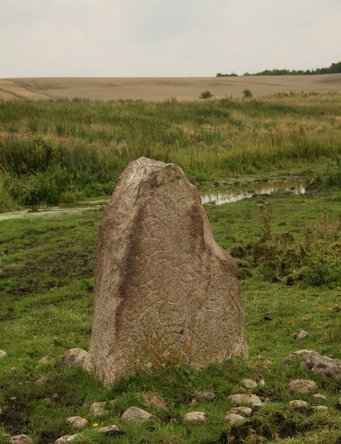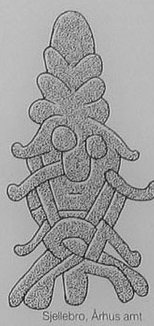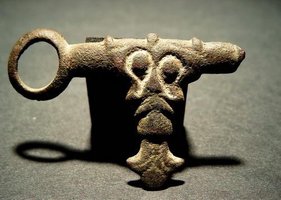The Sjellebro stone in Denmark - what is his face telling us ?
In 2008 I visited Denmark and followed the so called Viking Trail. One of the less obvious (and not very easy to find) monuments is the so called Sjellebro stone. It stands just in front of what appears to be an old river bedding, wich - at least at the time in summer as I was - almost was dry.
The mysterious stone of Sjellebro lay unnoticed for centuries on a meadow but hit the national headlines in 1951. The owner of the meadow, Åge Sørensen, noticed some carvings on it and called in the National Museum of Denmark. The stone was examined and gave up its secret: it had been decorated with a mask in about the year 1000 – the Viking era. The mask has big empty eyes, a pointed chin and plaited beard, and might depict a troll or bogeyman. The Sjellebro stone still stands in a grassy field on the north side of the stream and is visible from the road.
Again, the attractiviness of this monument is, that it still is 'in place' as it was erected a thousand years ago. Several ideas excist about what the face represents. But, I am always asking myself 'Why ?' as is stated 'might depict a troll or bogeyman'.
Maria Paanum Baastup states: "The mask stone triggered an archaeological excavation that revealed it stood by a total of four prehistoric roads on top of each other, and the remains of a bridge. The roads were never in use at the same time, but replaced each other. The bottom two roads were covered with stones, whereas the subsequent roads were surfaced with planks. The mask stone probably dates back to the youngest road on top. It stood on the verge where travellers could see it. Perhaps it was meant to remind them of the bogeyman" who according to a fairly recent legend is said to have lived in the stream. This bogeyman demanded a new human sacrifice every few years. Or perhaps the Vikings already knew this bogeyman way back and erected the stone to scare him away? "
I like to ask her about her theory, and whereupon it is based. (is there anything in the written record or Norse mythology wich points this way ?). If I can get additional info on this, I will add it to this blog of course.
I remember having read that it also might have been a 'safeguard' man for travellers crossing the stream (or river as it might have been once). Archaeologic findings show that "Alling steam" has been crossed here by humans through thousands of years. Around year 752 a solid road was built of timber and around year 1.000 the road was improved.
The "Mask" stone should have had magic powers and protect the travellers against evil.We will never know for sure. The stone lacks - unlike other face mask stones as the Mask Stone from Aarhus - runic inscriptions.
An also interesting theory for being the face possibly depicting a merman had been expressed in another blog about this stone here. 'At Sjellebro it was in the old days important to beware that there was a merman in the river - and he claimed an annual human sacrifice. Sometimes it took years before accidents happened; once it took 6 years, but in the 7th year a waggon with 7 people crashed and they all perished in the river. The merman had got what belonged to him on back payment.
Various legends and sinister stories went from mouth to mouth through generations. An old woman told in the 1950s what her parents and grandparents had told her, about a married couple, who drowned in the crossing point on their way home from market in Randers. She knew their graves on the church yard in the village Lime.
Today the country croad at Sjellebro is broad and safe, and the merman has died - or at least disappeared, but both the legends and the finds from the excavations remind about the traffic of the past in the meadow downside Sjellebro Inn, west of the present Randers- Ebeltoft road. The place is quiet. Cars are quickly passing upon the road without noticing the ancient stone in the meadow or the pretty river valley, but the Merman is still waiting down there, speaking his old words: "Time has come - but the man has not yet come....."
A drawing of the Sjellebro stone face reveals more of the detail. Few runic stones can be found where they were raised many hundred years ago. Most stones were moved and used when building churches and dikes.
The inscription is dated as having been carved between 850-1050 C.E. based on the style of the mask, which is classified as being in the Mammen style. My personal opnion is that the curly tendrils are showing us distinct Ringerike style elements, so I am not so sure to adress this to the - earlier - Mammen style.
Marie Stoklund had written in her book Runes and Their Secrets: Studies in Runology she recorded 21 stones decorated with a total of 23 masks. Stylistically they run through various Viking Age art styles, as the Mammen style, Ringerike style, Urnes style and even the motif continued into the Romanesque period. She refers to 'picture stones find in Scandinavia' so I do not know if this includes the Danish mask stones. I will ask her this.
Also she is stating about he recorded 21 stones that 'The masks always show males in a state of sublime peace, with strong features, but showing no sign of aggression. They do not, for instance, bare their teeth. This is of great importance, since the showing of teeth is the most aggressive feature of man's and lion's body language'.
This notion would argue against the theory of the face depicting a troll or bogeyman. Within itself having the goal to scare people (or other spirits) of. Or an not so friendly merman even so..
Any additional ideas on the image ? Conatct me on : vikingsandartefacts@yahoo.com
One of my artefacts in my collection has a - somewhat similar long lenghty - face within it.
It is a horse fitting. I have never seen such a face on this sort of equestrian equipment item before, and again the mystery of what it might represent or why it was depicted on this specific part of equestrian equipment. It was found in England.
References:
Stoklund, M. Runes and Their Secrets: Studies in Runology, p. 45-46
http://www.kulturarv.dk/1001fortaellinger/en_GB/the-sjellebro-stone/stories
http://www.europe-today.com/denmark/viking11.html
http://thyra2005.blogspot.nl/2012/07/the-mask-in-stone.html
Well. I could have been with these stones until after dark, but as my wife wanted to travel on.. well.. I see you again, some day, hogback stones from Gosforth. And if you happen to be there one day, do not forget that monument on the outside...
Further on with the Cumbrian hogbacktour !
In - yes, luckily again in - St. Peter's church in Heysham, there is a truly beautiful hogback stone. The guide told us, it had been studyied by Thor Ewing, a writer, in 2000. in 'Understanding the Heysham hogback' A tenth century sculpted stone monument and its context (link), Thor Ewing tells in detail what he dicovered on the both sides of this hogback stone.
Just being brought in the church as late as the 1970's accompanied with some protest here and there among the church visitors, considered as being a token of old paganism, it had been remarkably nice preserved, and a lot of detail can be seen, still. Truly worthwile a visit.
I had a small debate with the guide in the church if the - zoomorphic, in my opinion - faces on the sides were lions (or hippo's). The guide doubted if the vikings could have known about lions. Well I guess so, concerning the runes on the Ancient Greek lion statue at the Arsenal, Venice. For example. Vikings did travel south..
But when he told me he was doubting the vikings 'discovered' (as the native inhabitants were of course, in the first place) America before Columbus, I decided to rest my case..
One has to know when to start and to end a conversation ..
Just discovered the book in a bookstore written by Geoff Holder - The guide to the mysterious Lake District, I knew there had to be another hogback stone in Lowther, St. Micheal's Church. With a promising image described in the text of 'a naval and a land-based force of shield-bearing vikings above a fish and what might be a coiled sea serpent. On the reverse is a row of female figures with snakes, possibly a representation of the hideous hag Hel'. Wow. If that did not sound as a true pagan promised land ..
Not complaing too much after all we have seen, this visit was the dissapointing one of them all. But if you wife states 'I am happy to have seen them' and I am answering 'Measuring is knowing' and the even more obligate verb 'handling 'if we did not see it at all, we wouldn't have known anything at all of how they were looking' the glass was again half full, at the last day of our journey..
The hogback stone appeared to be just being tolerated within the entrance segment part of the church. As something you never use anymore but you do not throw away - entirely. That sort of feeling emerged when seeing this hogback asylum seekers.. Bed, bath and bread, ás we say in Dutch, but no luxury at all and standing on some outcuts of wood, you would balance the table with at home..
Come on, St. Micheal's Church.. care a bit more of your 'children' !
This hogback stone was moved in the church in 1907. Hogback stones layed partially buried in the churchyard before it was dug up and moved into the church.
The promising depiction of a longship - as certainly can be seen after some studying - see http://vikingminds.co.uk/pages/longship
we have missed !
The stone itself is (157 x 50 x 30 cm) and very worn.
The hogback stones in Cumbria - very diverse in quality, but everyone worth a visit ! Especially on a gloomy day in late October ...
The churches to visit - see photos of resp. St. Andrew's church in Penrith, St. Mary's church in Gosforth, St. Peter's church in Heysham and St. Micheal's church in Lowther.
Did I miss out on another one in Cumbria ? Let me know !
In a next blog I will take you to four - still remaining utterly mysterious- statues 'guarding' the graveyard of St. Andrew's church in Dacre..
For the last blog of October 9th see this link.
References: (as always, links to where the books can be ordered are attached).
Edwards, B.J.N. Vikings in North West England - The artifacts (1998);
Emery, Gordon, CURIOUS CUMBRIA, The Lake District & Beyond: A celebration of Cumbria (2023)
Ewing, T. 'Understanding the Heysham hogback' A tenth century sculpted stone monument and its context ;
Hall, R. Viking Age archaeology in Britain and Ireland (first printed 1990, reprinted with amendments in 1995);
Holder, G. The guide to the mysterious Lake District (2009)
possibly also (as there within the part of Cumbria dealing with Carlisle, the Eden Valley, Barrow-in-Furness, Whitehaven and the west coast is being dealed with)
Holder, G. Paranormal Cumbria (2010)
http://vikingminds.co.uk/pages/longship


